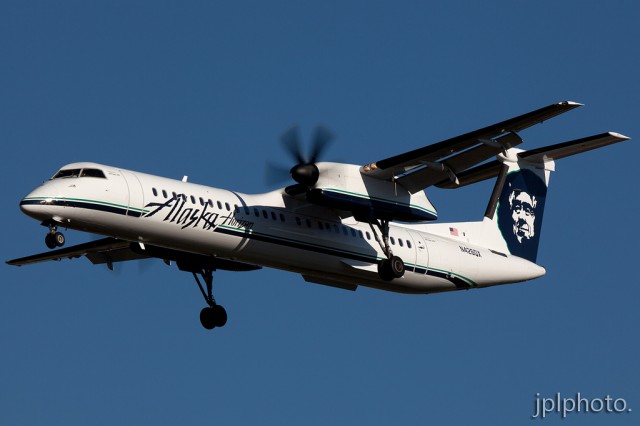
Alaska Airlines / Horizon Air Bombardier Q400. Image by Jeremy Dwyer-Lindgren.
What a cruddy week for Alaska Airlines (and Horizon Air) in the press. First they get accused of mistreating an elderly man with a disability, then accused of flying around with broken airplanes twice and a flight has to make an emergency landing.
So far, two of the stories have been picked up around the world and put the Seattle-based airline in a negative light. Might there be more to these stories than just the sensational headlines? Well, of course.
The first story involves a passenger with a disability. If you read the story in full, no question it is a sad one and it seems like someone with Alaska probably dropped the ball. However, this story really got out of control. The man, who has late stage Parkinson’s had difficulty understanding the check-in and boarding process. Ticket agents tried to explain his bag was too large to take to the gate, but he was not able to understand. It turns out that the agents thought the man was drunk and the passenger never self identified as someone with a disability who needed special assistance and it is illegal for the airline to ask if someone has a disability. So, you have a person who appears to be drunk, they smell alcohol (which can be a side effect of the Parkinson’s or medication), what are they supposed to do? Turns out that when the man tried to go through security, he was told to go back to check in his bag and he ended up missing his flight.
Another passenger, who saw what was happening, tried to help the man and his companion, who had MS, but did not have much luck. He did what many people do, rant on Facebook, but his rant went viral. Part of his post stated that Alaska employees were “the worst of humanity,” and the media took over the story from there.
There were many interesting headlines on this one, playing up that the employees were the worst of humanity. My favorite comes from The Daily Mail with, Alaskan Airlines faces outrage as staff are accused of ‘being the worst of humanity’ for ‘ignoring 70-year-old Parkinson’s sufferer’
Wait. Alaskan Airlines? Which airline is that? Well, I know that The Daily Mail is much more known for their shocking headlines than journalistic integrity. Anyhow, Alaska seemed to handle the situation the best that they could after knowing what happened.
“First and foremost, we’ve determined that we could and should have handled this better and I apologize to our passenger on behalf of all of us at Horizon Air and Alaska Airlines,” Horizon Air President Glenn Johnson wrote in a Facebook post. “This experience has reminded us of the importance of assisting passengers with disabilities and making sure every one of them receives the special care they may need. The information we’ve gathered during our review will certainly improve our efforts going forward.”
After Alaska realized what had happened, they refunded the man’s ticket and provided a second free ticket for a future flight.
“We’ve worked with a variety of disability organizations for years, which has helped us improve our service for travelers with disabilities,” said Ray Prentice, Alaska Airlines’ director of customer advocacy. “This incident provides another learning opportunity for our employees as well as for travelers with disabilities.”
Ironically, Alaska already had a meeting set up with the Open Doors Organization, which does disability advocacy.
According to Harriet Baskas with NBCNews, Eric Lipp, the group’s executive director confirmed that there are laws to help protect passengers with disabilities, ’œbut the law says the passenger has to self-identify. Otherwise, it’s a puzzle. The breakdown here is that the passenger didn’t self-identify and the airline didn’t have the right codes in the system to get him services he was entitled to.’
It was a bad experience that Alaska is surely learning from, but it seems that they aren’t evil and horrid, like so many are making them out to be.
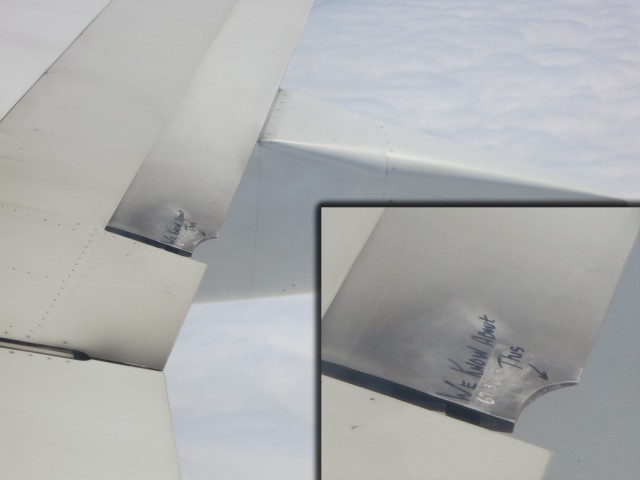
Is this something to really get worked up over?
Unrelated to the previous story, passengers on an Alaska Airlines flight got a bit disturbed seeing a piece of one of the flaps was cut off and the words “we know about this,” written in marker next to it. Sure, I get it. Seeing a part of the plane missing with a note would be a bit bothersome for most people. But is this enough to make global news?
It was a proper repair, the plane was safe to fly and this is a non-issue.
Alaska spokeswoman Bobbie Egan stated, “It was an approved trim repair to the corner flap on the right wing. A maintenance technician wrote to let the flight crew know. The message was the result of someone’s good intentions,” but she continued saying that it, “was not appropriate and did not follow company procedures.”
If these two other global-reaching stories were not enough, there have been two others more recently that have not been so good.
Flight 539 from Ontario, CA to Seattle declared an emergency after pilots had to pressurize the cabin manually. The aircraft’s air/ground sensor malfunctioned, which caused a series of electrical problems. The oxygen masks never deployed and the flight landed safely in San Jose, with no injuries. Surely not a great experience for the passengers on board.
Then, this morning, the FAA is proposing a $1million fine against Horizon Air (which operates Alaska Airlines flights) due to allegedly having 22 aircraft that were not in compliance with the FAA’s rules. According to KOMO News, the airline installed new security flight deck doors on 22 of their Bombardier Q400 aircraft, using blind rivets versus solid rivets. At this time, the airline has not responded to the allegations.
Obviously, this has not been a great week for the airline. However, Alaska has always been known with handling things quite well and has done as much as they can with the issues that come up. Let’s just hope that next week is a bit better for them.
UPDATE:
Here is Alaska Airlines response to the FAA fine:
Horizon Air has an uncompromising commitment to safety and compliance. We put the safety of our passengers, our employees and our aircraft above all else. Horizon takes any safety or compliance matter very seriously. We continually work with federal authorities to ensure the safety of our customers and that our aircraft are in full compliance with all federal aviation regulations while on the ground and in the air.
In the aftermath of 9/11, Horizon Air worked to install the FAA-mandated fortified flight deck door. To properly install the stronger door, nearby equipment on the Q400 flight deck had to be relocated. In relocating another piece of equipment, not associated with the door, Horizon opted to use an alternate, stronger rivet. At the time, Horizon believed this alternate rivet
was an acceptable substitution and that the carrier was within its authority to make the change.
In 2011, Horizon found several damaged wires shortly after performing the same installation procedure on a new aircraft. Horizon attributed the damage on this aircraft to the method used to install the alternate rivet. After this finding, the FAA questioned the use of the alternate rivet. While we believed at the time that the alternate rivet was a proper substitution, when the FAA expressed concern, we took immediate action to inspect our entire fleet and replace the alternate rivet with the specified rivet on all of the affected aircraft.
At no time was passenger safety comprised nor was the integrity of the flight deck door ever threatened by the use of this alternate fastener.
Since learning of the FAA’s concern, all maintenance procedures have been revised to ensure the use of the specified rivets when relocating hardware related to the installation of the fortified flight deck door.
Horizon Air is working cooperatively with the FAA to discuss the proposed $1,005,000 civil penalty associated with this rivet substitution. Nothing will be final until we have fully reviewed this matter with the FAA.
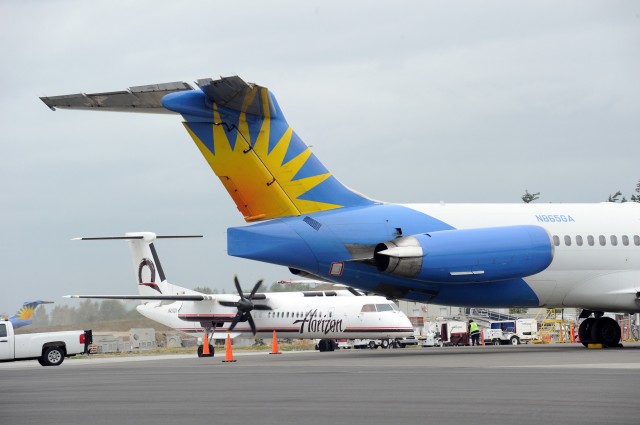
Horizon and Allegiant sit on the tarmac at BLI. Photo from the Port of Bellingham.
It is always fun when two airlines are able to duke it out at a smaller airport. Alaska Airlines and Allegiant have both been flying out of Bellingham International Airport (BLI) [located just south of the US/Canada border and about an hour and a half north of Seattle, WA] and the competition is about to get… well… more interesting.
BLI has been growing leaps and bounds over the past few years. From being a small regional airline to one that is handling more and more flights. In 2004, the airport saw almost 80,000 passengers and in 2011 that number rose to over 500,000.
Bellingham’s airport is pulling passengers from northern Washington and about 62% of their passengers are from Canada. It seems that both Allegiant and Alaska feel there is more demand, flying passengers to Hawaii.
Last week, Alaska put out a press release, announcing that they would start seasonal service between Bellingham and Maui (OGG) starting in November. This is interesting, since Allegiant previously announced starting non-stop service from BLI to OGG in November as well.
Although both airlines might not be too happy with the added competition, the airport likes providing more options to their passengers.
“The Port is very excited about the new destinations being offered by Alaska Air (Maui), Horizon Air (Portland, OR), Frontier Airlines (Denver, CO) and Allegiant Air (Honolulu and Maui),” Daniel J. Zenk, Director of Aviation at Bellingham International Airport explained to AirlineReporter.com. “Each new destination offers more flexibility and convenience at a low cost to our customers. The Port of Bellingham is proud of our partnership with the airlines and their ability to provide this service.”
Neither airline is willing to call out the other by name, but it is obvious that Alaska knows who they will be competing with. From their press release:
Alaska Airlines’ unique service offers many benefits for customers including:
- Free carry-on bags
- Free advance seat selection
- First class seating
- Complimentary inflight water, soft drinks, coffee and tea
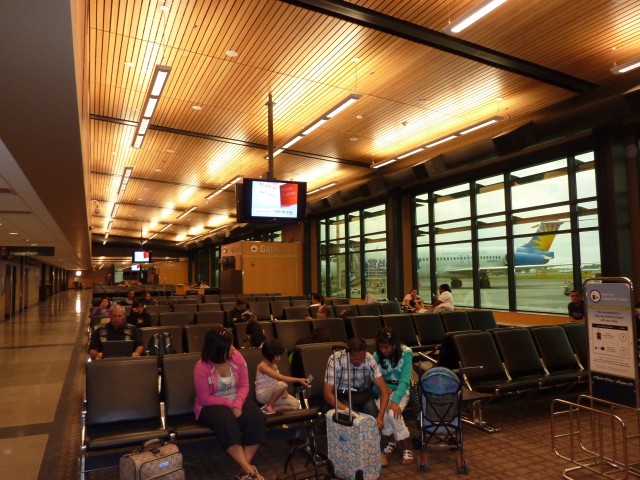
BLI recently opened a new terminal to help handle the increase of service. Photo from the Port of Bellingham.
See, Allegiant charges for carry-on bags, advance seat selection and drinks — they also only offer economy class seating. Even though Allegiant charges for these, the base-price for their flights will also most likely be cheaper and even after you add all the bells and whistles, they might still end up having a cost savings over Alaska.
Obviously, there is much more to choosing an airline than just cost and it will be interesting if cost or service will win out. Heck, there might be enough demand for both to succeed.
Allegiant is used to taking on other airlines and things do not seem any different in Bellingham. “The Allegiant business model is based on low-cost and value that stimulates new demand. This approach has led to 37 consecutive profitable quarters and will continue to help us grow,” Jessica Wheeler, Allegiant’s Public Relations Manager explained via email. “Our service in Bellingham has been very successful, and we are confident that all of our routes out of Bellingham will continue to attract new leisure travelers to our destinations.”
Alaska Airlines will start flying from Bellingham to Maui on November 8th using a Boeing 737-800, leaving at 3:00pm on Mon, Tue, Thu and Saturday. The return flight will be leaving at 11:00am from Maui on Tue, Wed, Fri and Sun. The airline will run the service through to winter until April 14th.
Allegiant will start flying from BLI to OGG on November 14th using a Boeing 757-200. At this point, the airline has not announced an official schedule.
Game on…
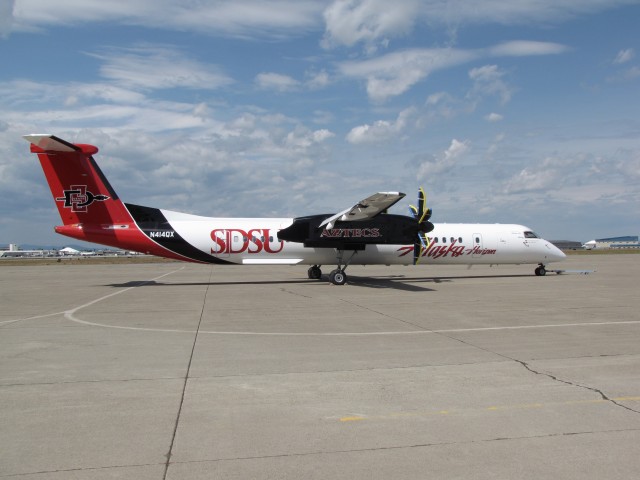
The newest livery on Horizon's Q400 is one for the San Diego State University Aztecs. Image from John David Wicker.
Horizon Air, which operates Capacity Purchase Agreement flights for sister carrier Alaska Airlines, is the eighth largest regional airline and is based in Seattle, WA. Recently, their own Horizon livery disappeared and was replaced by Alaska’s Eskimo, but the airline still retained a nice collection of unique liveries.
On May 31st, Alaska showed off their newest livery: San Diego State University at San Diego International Airport (SAN). The unveiling of the new livery was timed to celebrate the start of Alaska Airlines new San Diego flights to Fresno, Monterey and Santa Rosa, Calif., which began on June 4 and 5.
’œWe’re proud to add San Diego State University’s bold colors to our fleet of university planes and especially pleased that this aircraft represents our first California school,’ said Joe Sprague, Alaska Airlines’ vice president of marketing. ’œWe hope the Aztec plane will bring smiles to our passengers and be a source of pride for SDSU students, alumni and faculty for years to come as we fly it throughout our regional route network.’
It took a crew of eight people working around the clock for seven days at Associated Painters, located in Spokane, WA to paint the SDSU livery. The painting required 32 gallons of white paint, 10 gallons of red paint and four gallons of black paint. In addition, about 2,000 sheets of sandpaper and 10,000 yards of masking tape were also used.
Check out the gallery below for additional special Horizon/Alaska Q400 liveries:
[nggallery id=4]
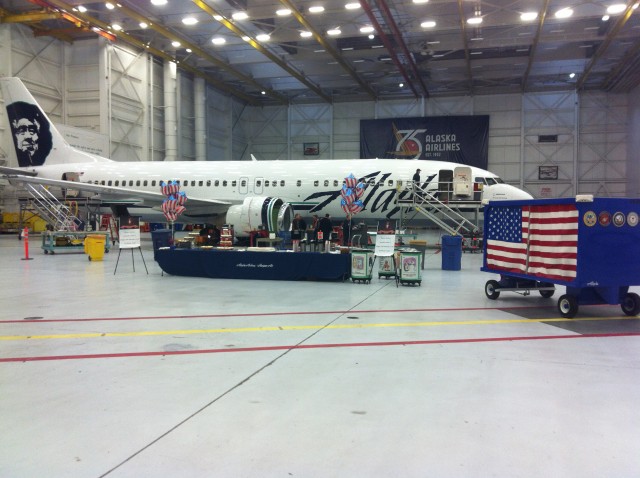
iPhone photo I was able to take of an Alaska Airlines Boeing 737 and the fallen soldier baggage cart at the airline's maintenance facility in Seattle during a special Veteran's event in November 2011.
Today is Memorial Day, where hopefully most people are able to at least take a moment and think about those who have given the ultimate sacrifice serving our country. It is a day where it shouldn’t matter if you support war or even what political party you vote for. It should be a day where we remember those men and women who have been killed while serving in the armed forces.
When a solider dies while serving, it is a delicate process to bring their body back home. There are special military protocols that airlines must follow when transporting the remains of a fallen solider, but some airlines don’t want to do the bare minimum. Each body must have a volunteer escort that follows the fallen solider from the mortuary to their final resting place.
About a year ago, Alaska Airlines technicians realized that the process of transporting a fallen solider was lacking and they looked to improve it.
“We noticed a lot of violations of military protocols due to a lack of awareness and training,” said Brian Bowden, an Alaska Airlines line aircraft technician. “Our goal is to show respect by ensuring the proper standards are followed.”
Bowden and 13 other technicians created a new “Fallen Solider” program to, “seamlessly transfer the remains of soldiers killed in action through Seattle-Tacoma International Airport.” Part of that program was creating a special baggage cart that would only be used to transport fallen soldiers. The cart was refurbished with carpet and has a retractable American flag curtain with plaques representing the Army, Navy, Air Force and Marines.
The program gives details on how to properly load and unload a soldier’s remains, as well as taking care of the escort or families. “These brave men and women sacrificed their lives for you and me,” line aircraft technician Tony Sander stated. “Often, their families are traveling alongside the fallen soldier. Mishandlings are embarrassing and unacceptable.”
Escorts will fly in the main cabin, while the fallen soldier will fly in the cargo hold. During layovers, escorts need to stay with the fallen soldier at all times and that can be challenging. Alaska has gone out of their way to provide escorts or others travelling with the remains, a working station at the airline’s maintenance facility. Airline crew will also make sure that the escort is well fed during any down time and cater to any of their other needs.
Many of the technicians who worked on the program are veterans themselves and take great pride in taking care of their own. “The technicians wanted ownership. The group has many passionate ex-military members who re-designed the process completely on their own time,” said Paul Taylor, director of line maintenance. “They took decisive action and lived up to their word.”
The program has been so successful that it has spread beyond Seattle and to other airports. “This process needs to reach all the airports we serve. Training at our other sites would spread a deeper respect for all the fallen soldiers of our armed forces,” technician Bowden said.
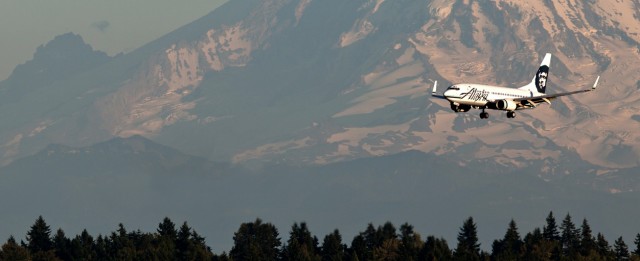
An Alaska Airlines Boeing 737 coming in for a landing. Photo by Jeremy Dwyer-Lindgren.
A big cheers to Alaska Airlines and the technicians who took the initiative to do the right thing.
On top of the Fallen Soldiers program, Alaska has a 100 person Employee Military Resource Group whose sole focus is to hire, retain and promote military employees.
Alaska has also recently started a new apprentice program, aimed directly at military experience and the transition to civilian/corporate work. Alaska proudly employees veterans who work in all capacities from maintenance to flying to the executive offices.
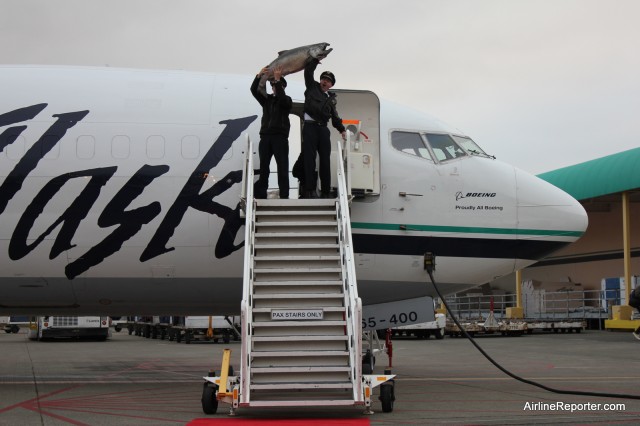
The Copper River Salmon has arrived to Seattle on a Boeing 737-400 Combi.
It has become a yearly tradition to wake up before it gets light and head on down to Alaska Air Cargo at Seattle-Tacoma International Airport (SEA) to welcome the season’s first Copper River Salmon. When that alarm goes off early in the morning, it is easy to question why would one get up so early to welcome
some fish?
Well, this is not just any fish, but many say one of the best in the world. There was huge fanfare as airline employees, media and guests welcomed the VIP salmon to Seattle.
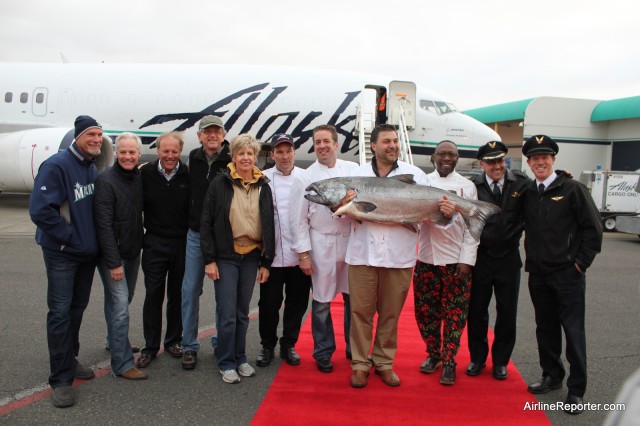
That is one big fish. Judges, pilots and chefs show off the 55 pound salmon.
“We’re proud to be the first to bring wild and sustainable Copper River salmon to seafood lovers across the country, in many cases within 24 hours after the fish is caught,” said Torque Zubeck, managing director of Alaska Air Cargo. “With enhanced food quality procedures and additional flights to support the Alaska seafood industry, we are going the extra mile to deliver seafood that’s as fresh as possible.”
The captain has the privilege to grab the largest fish and take it off the aircraft. This year, he was able to find a whopper — 55 pounds.

Cooking salmon in the outdoors early in the morning at an airport -- what more does one need?
It is not just about welcoming some fish, but also to have an epic Alaska Air Cargo’s “Copper Chef Cook-off.” This year executive chef Pat Donahue from Anthony’s Restaurant, Jason Wilson of CRUSH and Wayne A Johnson of Ray’s Boathouse competed to make the best Copper River Salmon dish in just 30 minutes.
The large fish was taken to be filet, divided up and given to the chefs. Each restaurant has their own outdoor cooking station and are able to do their thing.

The judges have the hard job of eating salmon, drinking wine and making the big decision for the winner.
During the 30 minute cook time, guests were entertained by local celebrity Jon Curley. He interacted with the cooks, judges and guests who each donated 75,000 miles to Make A Wish Foundation to earn a ticket to the event. A total of 1.2 million miles were donated for the enve.
After the meals were prepared a panel of judges voted on the best. The judges consisted of Jay Buhner, Seattle Mariners Hall of Famer; Joanne Dunham, co-owner of Dunham Cellars; Gary Horner, senior winemaker at Erath Winery; and Bill Ayer, chairman of Alaska Air Group.

Pat Donahue from Anthony's Restaurant celebrates this victory for the third year in a row. Former Mariner Jay Buhner hands out the awards.
When everything was said and done the winner, for the third year in a row was Anthony’s Restaurant.
This is the third year that Alaska Cargo has celebrated the salmon and each year it seems to be a bit better. (See the events in 2011 and 2010)
Alaska Airlines flew nearly 25 million pounds of fresh Alaska seafood to the Lower 48 states and beyond last year, including nearly 1.8 million pounds of Copper River salmon. The airline flies a total of 115 million pounds of cargo annually.
View all 18 photos from the event this morning or check out all three recipes made this morning.











